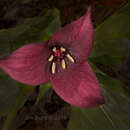Comments
(
Inglês
)
fornecido por eFloras
Although sometimes submerged within Trillium erectum, T. vaseyi has a later blooming season, a nodding flower of much larger size, a sweet fragrance, and cove habitat unlike that of T. erectum. In my garden hybridization experiments, T. vaseyi hybrids have different color patterns than T. erectum hybrids. Trillium vaseyi is clearly a distinct species. It frequently hybridizes with T. rugelii.
- licença
- cc-by-nc-sa-3.0
- direitos autorais
- Missouri Botanical Garden, 4344 Shaw Boulevard, St. Louis, MO, 63110 USA
Description
(
Inglês
)
fornecido por eFloras
Rhizomes short, stout, praemorse. Scapes 1–2 per rhizome terminus, round in cross section, 3–6.5 dm, ± slender to stout, glabrous. Bracts sessile to subsessile; blade rhombic, 10–20 × 6–20 cm, often wider than long, not glossy, base attenuate, apex acuminate. Flower carried beneath bracts, odor faintly sweet; sepals spreading, pale green, lanceolate-acuminate, 25–50 × 6–18 mm, margins involute, apex acuminate; petals spreading to recurved distally, adaxially crimson, maroon-red, or brownish red, abaxially paler, grayish pink or rose, veins engraved, ovate-suborbicular, 3–6.5 × 4–6 cm, somewhat fleshy, base rounded and overlapping, margins entire, apex acute; stamens conspicuous, ± erect to weakly recurved, 15–25 mm, longer than pistil at anthesis; filaments grayish purple to blackish purple, longer than anthers, 5–12 mm, slender; anthers weakly recurving, grayish purple to maroon, slender, dehiscence introrse; connectives purple, barely equaling anther sacs; ovary small, maroon or dark reddish purple, ± globose to conical-pyramidal, 6-ridged, 3–12 mm, basal attachment less than ovary width; stigmas erect, recurved, distinct, gray-purple, not lobed adaxially, basally widened, ± linear distally, 2.5–6.5 mm, fleshy; pedicel horizontal to declined-drooping, ± straight, 2–13 cm. Fruits dark reddish maroon, ovoid, obtusely angled, relatively small, 1–1.4 × 1–2 cm, pulpy. 2n = 10.
- licença
- cc-by-nc-sa-3.0
- direitos autorais
- Missouri Botanical Garden, 4344 Shaw Boulevard, St. Louis, MO, 63110 USA
Distribution
(
Inglês
)
fornecido por eFloras
Ala., Ga., N.C., S.C., Tenn.
- licença
- cc-by-nc-sa-3.0
- direitos autorais
- Missouri Botanical Garden, 4344 Shaw Boulevard, St. Louis, MO, 63110 USA
Flowering/Fruiting
(
Inglês
)
fornecido por eFloras
Flowering mid--late spring (late Apr--early Jun).
- licença
- cc-by-nc-sa-3.0
- direitos autorais
- Missouri Botanical Garden, 4344 Shaw Boulevard, St. Louis, MO, 63110 USA
Habitat
(
Inglês
)
fornecido por eFloras
Rich woods, often on steep slopes, ravines, stream banks, and deep, wind-sheltered, moist coves; 300--700m.
- licença
- cc-by-nc-sa-3.0
- direitos autorais
- Missouri Botanical Garden, 4344 Shaw Boulevard, St. Louis, MO, 63110 USA
Synonym
(
Inglês
)
fornecido por eFloras
Trillium erectum Linnaeus var. vaseyi (Harbison) H. E. Ahles
- licença
- cc-by-nc-sa-3.0
- direitos autorais
- Missouri Botanical Garden, 4344 Shaw Boulevard, St. Louis, MO, 63110 USA
Trillium vaseyi
(
Inglês
)
fornecido por wikipedia EN
Trillium vaseyi, the sweet wakerobin[5] or sweet beth, is a spring flowering perennial plant which is found only in the southeastern United States, primarily in the southern part of the Appalachian Mountains but with a few populations farther south.[4][6][7][8][9]
Description
Sweet wakerobin has among the largest flowers in the trillium family, with red petals up to 7 cm long. It grows in rich woods, sometimes on riverbanks but other times on steep slopes.[10]
Taxonomy
Trillium vaseyi was described by American botanist Thomas Grant Harbison in 1901.[3]
Conservation
As of April 2023, the global conservation status of Trillium vaseyi is listed as vulnerable and near threatened by NatureServe and IUCN (resp.).[1][2] It is critically imperiled in Alabama.
References
-
^ a b "Trillium vaseyi". NatureServe Explorer. NatureServe. Retrieved 7 April 2023.
-
^ a b "Texas Trillium (Trillium vaseyi)". The IUCN Red List of Threatened Species, Version 2022-2. Retrieved 7 April 2023.
-
^ a b "Trillium vaseyi Harb.". International Plant Names Index (IPNI). Royal Botanic Gardens, Kew; Harvard University Herbaria & Libraries; Australian National Botanic Gardens. Retrieved 1 April 2023.
-
^ a b "Trillium vaseyi". World Checklist of Selected Plant Families (WCSP). Royal Botanic Gardens, Kew.
-
^ USDA, NRCS (n.d.). "Trillium vaseyi". The PLANTS Database (plants.usda.gov). Greensboro, North Carolina: National Plant Data Team. Retrieved 15 December 2015.
-
^ Harbison, T. G. (1901). "New or little known species of Trillium". Biltmore Botanical Studies. 1 (1): 24. Retrieved 7 October 2019.
-
^ Barksdale, Lane 1938. Journal of the Elisha Mitchell Scientific Society 54(2): 285
-
^ Tropicos, Trillium vaseyi Harb.
-
^ Biota of North America Program 2014 county distribution map
-
^ Case Jr., Frederick W. (2002). "Trillium vaseyi". In Flora of North America Editorial Committee (ed.). Flora of North America North of Mexico (FNA). Vol. 26. New York and Oxford – via eFloras.org, Missouri Botanical Garden, St. Louis, MO & Harvard University Herbaria, Cambridge, MA.
- licença
- cc-by-sa-3.0
- direitos autorais
- Wikipedia authors and editors
Trillium vaseyi: Brief Summary
(
Inglês
)
fornecido por wikipedia EN
Trillium vaseyi, the sweet wakerobin or sweet beth, is a spring flowering perennial plant which is found only in the southeastern United States, primarily in the southern part of the Appalachian Mountains but with a few populations farther south.
- licença
- cc-by-sa-3.0
- direitos autorais
- Wikipedia authors and editors

